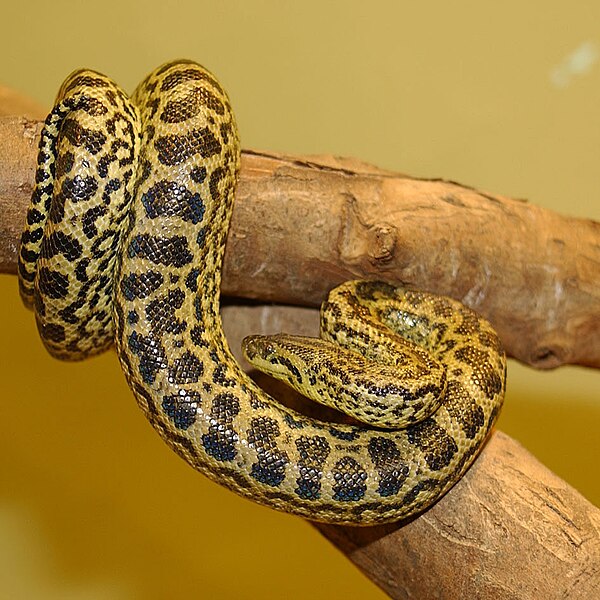The massive Green Anaconda (Eunectes murinus) is one of the world’s best-known snakes. I had the good fortune of participating in the first long-term study of this species in the wild (please see this article), and zoos have kept and bred them for decades. But its relatives, despite being large, impressive creatures, have not been well studied. One, the Bolivian Anaconda (E. beniensis), was only described in 2002, and its natural history remains shrouded in mystery; we know only a bit more about the Dark-Spotted Anaconda (E. deschauenseei). The Yellow Anaconda (E. notaeus) regularly appears in zoos and the pet trade, but field studies are lacking.
Dark-Spotted or De Schauensee’s Anaconda, Eunectes deschauenseei
Although described as a distinct species back in 1936, the habits of the Dark-Spotted Anaconda remain unstudied, and it rarely appears in public collections. While working with Green Anacondas in Venezuela, I tried to arrange a side trip to an area where they were reported to live, but was unable to arrange it. A review of the acquisition records at the Bronx Zoo, where I worked for many years, revealed that several specimens were believed to be this species, but none were definitely identified as such. I recently poked around among stored Green Anacondas in the collection of the American Museum of Natural History (courtesy of a colleague there) and hope to return to check on Dark-Spotted Anacondas. Although widely separated in range from the Yellow Anaconda, many taxonomists hold that the two are closely related.
The Dark-Spotted Anaconda is found in French Guiana and the states of Para and Amapa in northeastern Brazil, and possibly in Suriname. In common with other anacondas, it is highly aquatic and favors densely-vegetated waters that are difficult to survey. Therefore, we may not know the exact extent of its range. Having spent hours trying to find huge Green Anacondas in small pools of water, I can well-imagine that we have more to learn about the range of this elusive reptile.
Females likely top out at approximately 10 feet in length, but surprises could be in store for us. Like its relatives, the Dark-Spotted Anaconda has a wide appetite…fish, mammals, lizards and wading birds have been reported in its diet.
The IUCN lists this species as “data deficient”, and has not accessed its status. In areas where seasonally-flooded grasslands form the primary habitat, it is likely threatened by agricultural expansion. Populations living in swamps may be more secure.
Bolivian or Beni Anaconda, Eunectes beniensis
The Bolivian Anaconda is hunted for its skin and meat, and in some areas is killed as a threat to chickens and other domestic animals. However, as much of its habitat is sparsely populated and difficult to develop, the IUCN lists this species as “least concern”.
Yellow Anaconda, Eunectes notaeus
The Yellow Anaconda, first described in 1862, ranges from southeastern Bolivia through Paraguay, Uruguay, western Brazil and northeastern Argentina. At 10-12 feet in average length, with some females approaching 15 feet, it is the largest of the “other anacondas”. Those I’ve handled have been stoutly-built, although not, it seemed, to the same degree of their larger cousin, the Green Anaconda.
The Yellow Anaconda dwells in the same habitat types as the Green, and like it is also an ambush predator. Other similarities include the formation of mating balls during the breeding season and a taste for a wide variety of creatures…birds and their eggs, fish, lizards, caiman, capybaras, pacas, brocket deer and a host of other animals have been recorded as prey.
Green Anaconda, Eunectes murinus
I’ve captured and tagged some very large Green Anacondas, and have had the chance to observe mating, deer predation, “human stalking” and scores of other fascinating behaviors. Please see this article and those linked above and below to learn more about this secretive giant
Titanoboa, the Largest Known Snake

Further Reading
Green Anaconda Attacks: Notes from the Field
Video: Green Anaconda captures a Capybara
Yellow Anaconda Harvesting and Management in Argentina
Dark-Spotted Anaconda, IUCN Evaluation
Bolivian Anaconda image referenced from wikipedia and originally posted by
Dark Spotted Anaconda image referenced from wikipedia and originally posted by C. Schuhmacher
Bolivian Anaconda image referenced from wikipedia and originally posted by Phillie Casablanca
Yellow Anaconda image referenced from wikipedia and originally posted by Patrick Jean
 That Reptile Blog – Reptile, Amphibian and Exotic Pet Care and Information
That Reptile Blog – Reptile, Amphibian and Exotic Pet Care and Information




Hey Mr. Idiviglio,
Haven’t been on here in a while. I recently acquired a Dumeril’s Boa and I wanted to know if you had any tips on it’s care or have any advice on it. I’m still looking for a Musk Turtle; I have gotten close to buying some but somehow I end up not doing so.
Cheers, Alex
Hi Alex,
Nice to hear from you, I hope all is well.
I’ve worked with them often; recently set up an exhibit at a local zoo, with animals that had been confiscated because of permit defects.
Care follows that of other boas; they hail from arid regions so cage should be dry. Misting fine, as long as tank dries out. Ambient temp 80 F or so, basking 95 F, dip at night ok. Common for them to dislike handling, at least as adults, but much variation re this. Small ones can eat each 7-10 days, larger best fed every 2 weeks, metabolism seems slower than some relatives.
Enjoy, please keep me posted, and let me know if you get a musk , Best., Frank